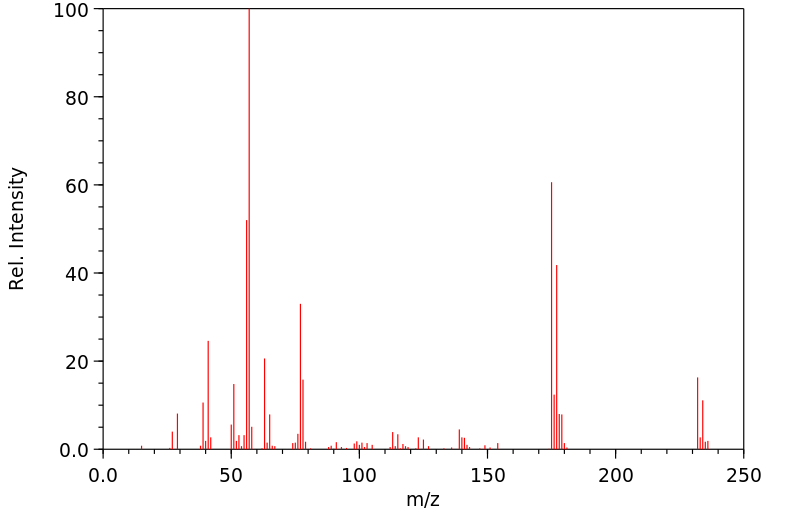t-丁基苯基二氯硅烷 | 17887-41-1
中文名称
t-丁基苯基二氯硅烷
中文别名
叔丁基苯基二氯硅烷
英文名称
phenyl-tert-butyldichlorosilane
英文别名
tert-butylphenyldichlorosilane;tert-butyldichloro(phenyl)silane;tert-butyl-dichloro-phenylsilane
CAS
17887-41-1
化学式
C10H14Cl2Si
mdl
MFCD00051441
分子量
233.213
InChiKey
OCXPCSGIIJESOA-UHFFFAOYSA-N
BEILSTEIN
——
EINECS
——
-
物化性质
-
计算性质
-
ADMET
-
安全信息
-
SDS
-
制备方法与用途
-
上下游信息
-
文献信息
-
表征谱图
-
同类化合物
-
相关功能分类
-
相关结构分类
物化性质
-
沸点:126 °C
-
密度:1.106
-
闪点:83°C
计算性质
-
辛醇/水分配系数(LogP):3.67
-
重原子数:13
-
可旋转键数:2
-
环数:1.0
-
sp3杂化的碳原子比例:0.4
-
拓扑面积:0
-
氢给体数:0
-
氢受体数:0
安全信息
-
TSCA:Yes
-
安全说明:S26,S36/37/39,S45
-
危险类别码:R34
-
危险品运输编号:UN 2987
-
海关编码:2931900090
-
储存条件:存放于惰性气体中,并避免接触湿气(否则可能发生分解)。
SDS
反应信息
-
作为反应物:描述:t-丁基苯基二氯硅烷 在 lithium 作用下, 以 四氢呋喃 为溶剂, 反应 0.5h, 以45%的产率得到1,2,3,4-tetra-t-butyl-1,2,3,4-tetraphenylcyclotetrasilane参考文献:名称:Synthesis of the Cyclotetrasilanes of the Type[(PhRSi)4] (R=t-Bu;t-BuCH2)摘要:锂与相应的二氯硅烷(PhRSiCl2)发生还原偶联,制备出了[(PhRSi)4](R=t-Bu;t-BuCH2)型环四硅烷。DOI:10.1246/bcsj.59.3314
-
作为产物:描述:苯基三氯硅烷 在 t-C4H9Li 作用下, 以 not given 为溶剂, 以80%的产率得到t-丁基苯基二氯硅烷参考文献:名称:Gmelin Handbuch der Anorganischen Chemie, Gmelin Handbook: Si: MVol.C, 58, page 165 - 167摘要:DOI:
文献信息
-
Palladium‐Catalyzed Synthesis of Benzophenanthrosilines by C−H/C−H Coupling through 1,4‐Palladium Migration/Alkene Stereoisomerization作者:Tomohiro Tsuda、Yuka Kawakami、Seung‐Min Choi、Ryo ShintaniDOI:10.1002/anie.202000217日期:2020.5.18catalysis. The reaction mechanism has been experimentally investigated and a catalytic cycle involving a C-H/C-H coupling through a new mode of 1,4-palladium migration with concomitant alkene stereoisomerization has been proposed.
-
Asymmetric Synthesis of Silicon‐Stereogenic Silanes by Copper‐Catalyzed Desymmetrizing Protoboration of Vinylsilanes作者:Ge Zhang、Yanfei Li、Ying Wang、Qian Zhang、Tao Xiong、Qian ZhangDOI:10.1002/anie.202005341日期:2020.7.13The catalytic asymmetric creation of silanes with silicon stereocenters is a long‐sought but underdeveloped topic, and only a handful of examples have been reported. Moreover, the construction of chiral silanes containing (more than) two stereocenters is a more arduous task and remains unexploited. We herein report an unprecedented copper‐catalyzed desymmetrizing protoboration of divinyl‐substituted
-
Catalytic Enantioselective Synthesis of Alkenylhydrosilanes作者:Kazunobu Igawa、Daisuke Yoshihiro、Nobumasa Ichikawa、Naoto Kokan、Katsuhiko TomookaDOI:10.1002/anie.201207361日期:2012.12.14Asymmetric silanes: A synthesis of nonracemic alkenylhydrosilanes has been developed based on the desymmetrization of a dihydrosilane through alkenylation with an alkyne using an asymmetric catalyst. The alkenylhydrosilane product can be used as a versatile chiral building block for other functionalized nonracemic silanes through the stereoselective conversion of its hydride and/or alkenyl moiety.
-
Silicon Tethered Alkenyl Transfer and Type I Ene Reactions作者:Jeremy Robertson、Garry O'Connor、Caroline L. Ringrose、Donald S. MiddletonDOI:10.1016/s0040-4020(00)00738-9日期:2000.10effecting silicon tethered Type I ene cyclisations analogous to our previously reported Type II variant. Some of these substrates were found to undergo overall stereospecific alkenyl transfer via silacyclopentanol intermediates; in a homologous series, alkenyl transfer was accompanied by dehydration to provide 7-silylhepta-2,4-dienes in moderate yield. Formal Type I ene cyclisations were found to be
-
Enantioselective Synthesis of Silacyclopentanes作者:Kazunobu Igawa、Daisuke Yoshihiro、Yusuke Abe、Katsuhiko TomookaDOI:10.1002/anie.201511728日期:2016.5.4A variety of functionalized silacyclopentanes were synthesized by highly enantioselective β‐eliminations of silacyclopentene oxides followed by stereospecific transformations. The reaction mechanism of the β‐elimination was elucidated by DFT calculations. An in vitro biological assay with an oxy‐functionalized silacyclopentane showed substantial binding to a serotonin receptor protein.
表征谱图
-
氢谱1HNMR
-
质谱MS
-
碳谱13CNMR
-
红外IR
-
拉曼Raman
-
峰位数据
-
峰位匹配
-
表征信息
同类化合物
(2-溴乙氧基)-特丁基二甲基硅烷
鲸蜡基聚二甲基硅氧烷
骨化醇杂质DCP
马沙骨化醇中间体
马来酸双(三甲硅烷)酯
顺式-二氯二(二甲基硒醚)铂(II)
顺-N-(1-(2-乙氧基乙基)-3-甲基-4-哌啶基)-N-苯基苯酰胺
降钙素杂质13
降冰片烯基乙基三甲氧基硅烷
降冰片烯基乙基-POSS
间-氨基苯基三甲氧基硅烷
镓,二(1,1-二甲基乙基)甲基-
镁,氯[[二甲基(1-甲基乙氧基)甲硅烷基]甲基]-
锑,二溴三丁基-
铷,[三(三甲基甲硅烷基)甲基]-
铂(0)-1,3-二乙烯-1,1,3,3-四甲基二硅氧烷
钾(4-{[二甲基(2-甲基-2-丙基)硅烷基]氧基}-1-丁炔-1-基)(三氟)硼酸酯(1-)
金刚烷基乙基三氯硅烷
酰氧基丙基双封头
达格列净杂质
辛醛,8-[[(1,1-二甲基乙基)二甲基甲硅烷基]氧代]-
辛甲基-1,4-二氧杂-2,3,5,6-四硅杂环己烷
辛基铵甲烷砷酸盐
辛基衍生化硅胶(C8)ZORBAX?LP100/40C8
辛基硅三醇
辛基甲基二乙氧基硅烷
辛基三甲氧基硅烷
辛基三氯硅烷
辛基(三苯基)硅烷
辛乙基三硅氧烷
路易氏剂-3
路易氏剂-2
路易士剂
试剂Cyanomethyl[3-(trimethoxysilyl)propyl]trithiocarbonate
试剂3-[Tris(trimethylsiloxy)silyl]propylvinylcarbamate
试剂3-(Trimethoxysilyl)propylvinylcarbamate
试剂2-(Trimethylsilyl)cyclopent-2-en-1-one
试剂11-Azidoundecyltriethoxysilane
西甲硅油杂质14
衣康酸二(三甲基硅基)酯
苯胺,4-[2-(三乙氧基甲硅烷基)乙基]-
苯磺酸,羟基-,盐,单钠聚合甲醛,1,3,5-三嗪-2,4,6-三胺和脲
苯甲醇,a-[(三苯代甲硅烷基)甲基]-
苯并磷杂硅杂英,5,10-二氢-10,10-二甲基-5-苯基-
苯基二甲基氯硅烷
苯基二甲基乙氧基硅
苯基二甲基(2'-甲氧基乙氧基)硅烷
苯基乙酰氧基三甲基硅烷
苯基三辛基硅烷
苯基三甲氧基硅烷







